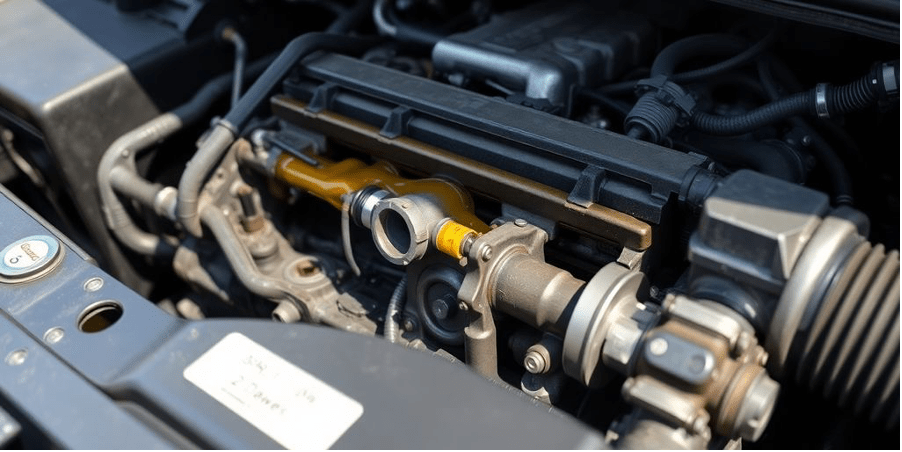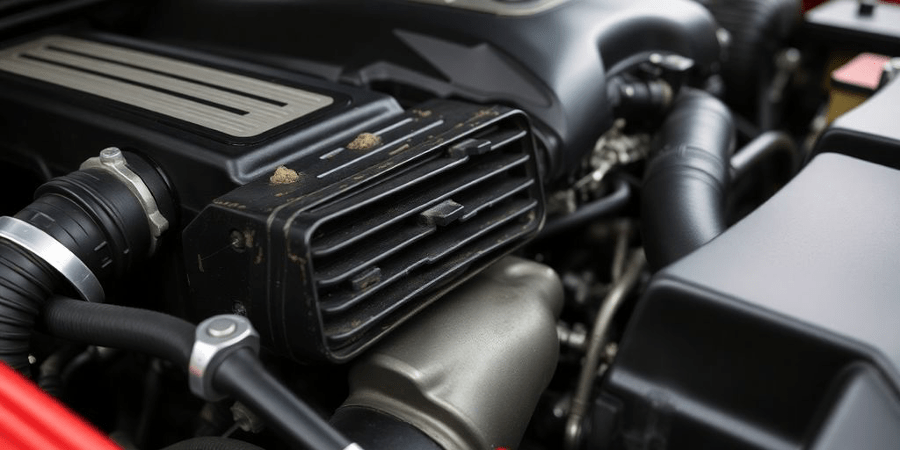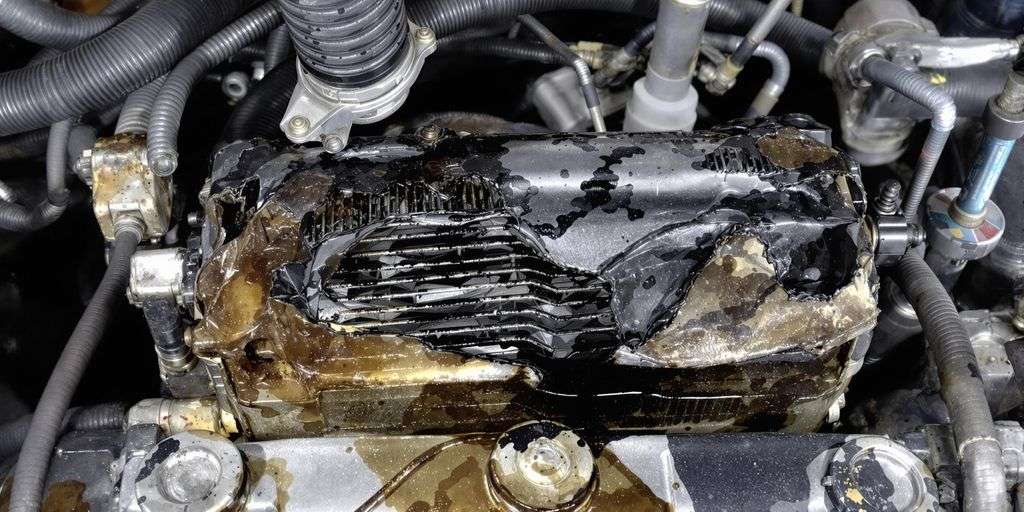Key Takeaways
- Identify the symptoms of a broken oil cooler early to avoid further damage.
- Consider the cost of repairs versus the car's value before selling.
- Be transparent with potential buyers about the oil cooler issue.
- Gather all maintenance records to present to buyers.
- Explore alternative selling options if traditional selling methods aren't working.
Understanding the Challenges of Selling a Car with a Broken Oil Cooler
Identifying the Symptoms of a Broken Oil Cooler
When you're dealing with a car that has a broken oil cooler, the first step is to recognize the signs. Common symptoms include leaking oil, which may appear as dark spots under your vehicle. You might also notice the engine running hotter than usual, or even overheating. Sometimes, there’s a mix of oil and coolant, which can cause a milky substance under the oil cap. Being aware of these symptoms early can prevent further damage.
Assessing the Extent of the Damage
Once you’ve identified the symptoms, the next step is to assess how bad the damage is. This could involve checking for visible cracks or leaks in the oil cooler itself. In some cases, replacing the O-rings or pipes can be a quick fix. However, if the damage is more severe, like a cracked cooler, it might need a full replacement. It’s a good idea to consult with a mechanic to understand the full scope of the issue.
Considering the Impact on Car Value
A broken oil cooler can significantly affect your car's value. Cars with known mechanical issues tend to sell for less. Potential buyers might see the broken oil cooler as a red flag, worrying about the cost of repairs. To get a fair price, you might need to adjust your asking price accordingly. It's crucial to be upfront about the issue when negotiating with buyers, as transparency can foster trust and lead to a smoother sale process.
Selling a car with a mechanical issue like a broken oil cooler is challenging, but with the right approach, you can still find a buyer who appreciates the car's overall value despite its flaws.
For those considering to bypass the external transmission cooler, it's feasible for a month or two, as long as you avoid towing or heavy hauling.
Preparing Your Car for Sale Despite a Broken Oil Cooler
Cleaning and Detailing the Vehicle
Before listing your car for sale, giving it a thorough cleaning can make a world of difference. A spotless car not only looks better but also gives the impression that it's been well taken care of. Start with a good wash and wax to make the exterior shine. Inside, vacuum the carpets and seats, wipe down all surfaces, and consider using a car freshener to eliminate any odors. Don't forget the small details like cleaning the windows and mirrors, as they can make the car feel newer.
Documenting the Oil Cooler Issue
Transparency is key when selling a car with issues. Make sure to document the problem with the oil cooler. Take clear photos of the affected area and note any symptoms the car exhibits, like oil leaks or overheating. Having this information ready can build trust with potential buyers, showing them you're upfront about the car's condition.
Gathering Maintenance Records
Having a complete set of maintenance records can be a big plus. It shows buyers that you've been diligent about the car's upkeep. These records should include routine services like oil changes and any repairs you've had done. If you've addressed issues related to the oil cooler, make sure those receipts are included too. This documentation can reassure buyers that the car, despite its current problem, has been well-maintained.
Exploring Repair Options Before Selling
When facing a broken oil cooler, it's essential to weigh your options carefully. Start by assessing whether a simple fix could solve the issue. Replacing seals or rings might be all that's needed to stop a leak. This approach is often more affordable than a full replacement, costing just a few dollars for parts.
- Check for visible leaks: Clean the area and observe for oil seepage.
- Inspect seals and gaskets: These are common culprits for leaks.
- Consider thicker seals: These might offer a more permanent solution if the original ones fail.
Before making any decisions, it's wise to consult with a professional mechanic. They can provide a detailed diagnosis, which can save time and money in the long run. Mechanics may suggest options like welding or using aftermarket parts, which can be more cost-effective than OEM replacements.
“Consulting a mechanic can turn guesswork into a solid plan, ensuring you're not spending more than necessary.”
Once you've gathered all the information, it's time to decide whether to repair or replace the oil cooler. Consider the following:
- Cost of repair vs. replacement: Sometimes, a new oil cooler can be more economical in the long run.
- Vehicle's overall condition: If other major repairs are needed, selling as-is might be more practical.
- Potential buyers' perception: A repaired vehicle might attract more buyers than one needing immediate attention.
For those looking to boost performance, a larger custom oil cooler could be a worthwhile investment, especially if the car is used on the track.
Marketing Strategies for Selling a Car with a Broken Oil Cooler
Highlighting the Car's Strengths
When selling a car with a broken oil cooler, it's essential to focus on the vehicle's positive attributes. Start by listing features like low mileage, recent upgrades, or a well-maintained interior. Emphasizing these strengths can attract buyers who might overlook the mechanical issue. Consider creating a list of standout features:
- Low mileage
- New tires or brakes
- Recent service records
Being Transparent About the Issue
Honesty is the best policy when dealing with potential buyers. Clearly explain the problem with the oil cooler and discuss any temporary fixes or potential solutions. Buyers appreciate transparency, and it helps build trust. If possible, provide documentation or a mechanic's report to support your claims.
Setting a Competitive Price
Pricing your car competitively is crucial, especially when there's a known issue. Research similar models on the market and adjust your price accordingly, factoring in the cost of repairs. A competitive price can make your car more appealing despite its problems. Consider using a table to compare:
| Model Year | Average Price | Your Price |
| 2015 | $10,000 | $8,500 |
| 2016 | $11,500 | $9,000 |
Selling a car with a mechanical issue might seem daunting, but with the right approach, you can still find the right buyer. Focus on transparency and competitive pricing to make the process smoother.
Remember, when marketing your car, it's all about balancing the good with the not-so-good, and pricing it just right to catch the eye of the right buyer.
Negotiating with Potential Buyers

Handling Buyer Concerns
When selling a car with a broken oil cooler, expect buyers to have concerns. Be upfront about the issue and explain the symptoms and what it means for the car’s performance. This transparency builds trust and can ease the negotiation process. Consider creating a simple table outlining potential repair costs and options, which can help buyers understand their future expenses. Here’s an example of what that might look like:
| Repair Option | Estimated Cost | Time to Repair |
| DIY Seal Replacement | $50-$100 | 1-2 hours |
| Professional Repair | $200-$500 | 1 day |
| Full Replacement | $600-$900 | 2-3 days |
Offering Test Drives
A test drive is a crucial step in the buying process, even if the car has issues. Let the buyer feel how the car handles and performs. Make sure to point out any noises or performance quirks related to the oil cooler during the drive. This honesty can actually work in your favor, as it shows you’re not hiding anything.
Finalizing the Sale Agreement
Once a buyer is interested, it’s time to close the deal. Draft a clear bill of sale that outlines the car’s condition and the agreed-upon price. This document protects both parties and ensures everyone is on the same page. Remember to include any terms about the oil cooler issue. This way, there won’t be any surprises later on.
Selling a car with a mechanical problem like a broken oil cooler might seem daunting, but with the right approach, you can find a buyer willing to take on the challenge. Keep communication open and honest, and you’ll have a better chance of sealing the deal.
Legal Considerations When Selling a Car with Known Issues

Selling a car that's not in perfect condition can be tricky, especially when it involves something as serious as a broken oil cooler. Here's what you need to know to navigate the legal side of things.
Understanding Disclosure Requirements
First off, you gotta be upfront about the car's condition. Transparency is key when you're selling a car with issues. Most states require you to disclose any known problems, and failing to do so could land you in hot water. It's not just about being honest; it's about protecting yourself from future disputes. In places like California, lemon laws have been updated to offer even more protection for buyers, so make sure you're aware of what you need to disclose.
Drafting a Bill of Sale
A well-drafted bill of sale is a must. This document should clearly outline the car's condition, including any known defects like the broken oil cooler. It's like a receipt that both parties sign, making sure everyone is on the same page. Include the car's VIN, sale price, and any terms agreed upon. This can prevent misunderstandings down the road.
Ensuring a Smooth Title Transfer
Finally, don't forget about the title transfer. It's your responsibility to make sure this process goes smoothly. Double-check that all the paperwork is accurate and complete. You might need to visit your local DMV or similar agency to finalize the transfer. This step is crucial to avoid any future liability or legal issues related to the car.
Taking care of these legal details not only helps you sell your car ethically but also gives you peace of mind knowing you've done everything by the book.
Alternative Selling Options for Cars with Mechanical Issues
Selling to a Mechanic or Repair Shop
One of the simplest ways to sell a car with a broken oil cooler is to approach a mechanic or a repair shop. These professionals often look for vehicles they can fix up and resell. It's a win-win situation: you get rid of the car without the hassle of repairs, and they get a project to work on. Make sure to be upfront about the car's condition and any other issues it may have. This honesty can help you avoid any disputes later on. You might not get top dollar, but it's a straightforward sale.
Considering Online Car Auctions
Online car auctions can be a great avenue for selling a car with mechanical issues. Websites dedicated to auctioning vehicles allow you to reach a broader audience. Potential buyers at these auctions often have the skills or resources to fix cars themselves. When listing your car, be clear about the oil cooler problem and any other mechanical issues. This transparency will attract buyers who are specifically looking for a fixer-upper.
Exploring Trade-In Opportunities
Trading in your car at a dealership is another option. While dealerships typically offer less money for cars with known issues, they do provide convenience. If you're planning to buy another vehicle, a trade-in can help reduce the purchase price. Discuss the oil cooler problem with the dealer to see if they can offer a fair trade-in value. Sometimes, they might even have connections with salvage yards that purchase non-running vehicles, which could work in your favor.
Selling a car with mechanical problems doesn't have to be a headache. Weigh your options and choose the path that best suits your needs and circumstances. Whether you sell to a mechanic, list it online, or trade it in, there's always a way to turn a tricky situation into a manageable one.
Wrapping It Up: Selling Your Car with a Broken Oil Cooler
So, there you have it. Selling a car with a busted oil cooler isn't the end of the world. Sure, it might seem like a hassle at first, but with a bit of patience and some elbow grease, you can get through it. Remember, honesty is key. Be upfront about the issue with potential buyers, and you might be surprised at how understanding people can be. Whether you decide to fix it yourself, get a mechanic involved, or sell it as-is, there's always a way forward. Just weigh your options, consider the costs, and make the choice that feels right for you. Good luck, and happy selling!
Frequently Asked Questions
What are the signs of a broken oil cooler?
Look for oil leaks under your car, overheating, or a drop in oil pressure. These can be signs that your oil cooler might be broken.
Can I sell my car if it has a broken oil cooler?
Yes, you can sell your car even if it has a broken oil cooler, but you should be honest about the issue with potential buyers.
How much does it cost to fix a broken oil cooler?
The cost can vary, but fixing a broken oil cooler might range from $100 to $500, depending on your car model and where you get it repaired.
Is it better to repair the oil cooler before selling the car?
Repairing it can increase your car's value and make it easier to sell, but it's not always necessary if you're upfront with buyers about the issue.
What if the new O-rings don't stop the leak?
If new O-rings don't fix the leak, the problem might be with the cooler itself or the pipes. You might need a mechanic to take a closer look.
Are there alternative ways to sell a car with a broken oil cooler?
Yes, you can sell it to a mechanic, try online auctions, or explore trade-in options with dealerships.



